Social
Human Rights and Non-Discrimination
The Company is aware of the importance and impact that may arise from human rights issues in business operations throughout the value chain. In order to prevent risks and build confidence on human rights issues in business operations, it has purposely operated according to the United Nations Framework and Guiding Principles on Business and Human Rights (UNGP) based on 3 principles of the human rights framework of Protect, Respect and Remedy.
Major operations in 2022
- After conducting a human rights due diligence process within the organization, it was found that the Company has no significant issues of risk and there have been no complaints or violations regarding human rights.
- Critical Tier 1 business partners of the Company were found that no issues of risk concerning human rights violations.
- Critical Non-Tier 1 business partners of the Company were found to have a low level of risk regarding the procurement of goods or services that may not be directly produce from its suppliers (Critical Tier 1). The Company has prepared preventive measures and mitigation strategies to minimize the impact, as well as corrective actions to address the aforementioned risks.
Policy on Human Rights and Non-Discrimination
The Company has reviewed and improved its policy on human rights and non-discrimination in line with the UN Guiding Principles on Business and Human Rights (UNGP), the Universal Declaration of Human Rights (UDHR), the Children’s Rights and Business Practices Principles: CRBP) and the United Nations Global Compact (UN Global Compact)
Human Rights and Non-Discrimination Policy
Human Rights Due Diligence Process (HRDD)
The company has implemented a comprehensive human rights due diligence process, referencing the guidelines set forth in the UN Guiding Principles on Business and Human Rights (UNGP), as a best practice for assessing human rights risks on an ongoing basis. This assessment is conducted every two years and follows the following steps:
- Determining the scope of process
The Company establishes clear scopes for a comprehensive and inclusive human rights review process that encompasses all relevant stakeholder groups, including vulnerable groups such as children, persons with disabilities, women, minorities, migrant workers, third-party contracted labor, indigenous people, local communities, LGBTQI+, senior citizens, and pregnant women. This review process is applicable to all operational areas where The Company conducts business or right to control, as well as stakeholders involved in the supply chain. The scope of human rights issues includes labor rights, community rights, supply chain, security and safety, environment and customer rights.
- Identifying relevant human rights issues
The Company reviews various human rights risks associated with the value chain, including both The Company's direct activities and the indirect activities of its business partners, contractors, and joint ventures, which may lead to human rights violations, including global trend in human rights issues within the same industry. Human rights risk issues are categorized and improve a comprehensive checklist for assessing human rights risks. Then, the relevant departments evaluate potential human rights risks that may arise from The Company's business activities.
- Human rights risk assessment
The Company assesses human rights risks using the Human Rights Risk Assessment Matrix, which considers the criteria for impact level and likelihood of human rights issues. The identified human rights risks are categorized into four levels: low, moderate, high, and very high, as shown in Figure 1.
Risk Assessment Criteria: Likelihood
Levels of Likelihood Characteristic of Likelihood 4 High Probability (>25%) The event has the potential to occur multiple times per year within the operational area. 3 Moderate Probability (10-25%) The event has the possibility of occurring occasionally within the operational area. 2 Low Probability (1-10%) The event has a very low chance of occurring within the operational area, but there is a possibility for it to happen. 1 Very Low Probability (<1%) The event occurs in an industry similar to the operational area, but the likelihood of this event happening in the operational area itself is very low. Risk Assessment Criteria: Impact
Levels of Likelihood Characteristic of Likelihood 4 High Impact - Human rights impacts that extend beyond the scope of the operational area or affect populations beyond its boundaries.
- The Company cannot directly control or mitigate human rights impacts to restore the violated rights of individuals.
- The impacts/events related to human rights issues require assistance from independent and trustworthy external organizations to effectively address them in collaboration with The Company.
3 Moderate Impact - The Company provides assistance or support in carrying out activities that may lead to human rights violations (Legal Complicity).
- Human rights impacts resulting from The Company's operations or the value chain of The Company, affecting stakeholders in some operational areas.
- The Company has human rights conflicts with vulnerable groups.
2 Low Impact - The Company benefits from activities that result in human rights violations carried out by other entities (Non-Legal Complicity), but it does not participate or support them in any way.
- The Company is unable to address concerns related to human rights from stakeholders, whether internal or external.
1 Very Low Impact - The potential impacts arising from concerns regarding human rights received from affected stakeholders, both internally and externally, are addressed and mitigated at the operational area level. This includes the management mechanisms for handling company complaints.

Figure 1 Prioritizing Human Rights Risk Issues
- Establishing mitigation and prevention measures
Once the human rights risk issues have been prioritized, the Company must anticipate various risks that may arise from these issues and develop measures to mitigate the potential negative impacts resulting from human rights risks. Especially in issues with high and very high-risk levels, to be used as a guideline to reduce and control negative impacts to be at a low or acceptable level, as well as to enhance positive impacts on individuals affected by these risks.
- Human rights issues monitoring and review
Due to human rights risks related to the Company's business operations, which may change with evolving activities and stakeholder groups, the Company must regularly review human rights risks and measures to mitigate and prevent. This includes setting indicators as a tool for monitoring and evaluating the Company's performance, such as the percentage of employees who have received human rights training, the number of complaints received and the status of solutions, etc. as well as annually reporting human rights performance through the sustainability report or the Company's website.
- Remediation actions
The Company has established mechanisms for receiving complaints through various channels in cases of human rights violations associated with the Company's activities. Therefore, the Company has defined appropriate corrective measures and provided remedies to individuals affected by such violations, both in financial and non-financial forms. Furthermore, the Company identifies lessons learned to develop preventive measures against future incidents.
Diversity in Sri Trang Gloves
Total Workforce

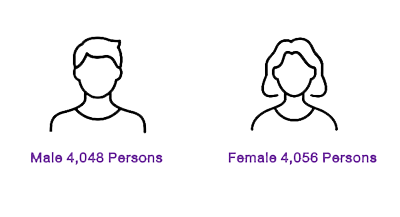
All management positions
(% of Total Management Workforce)
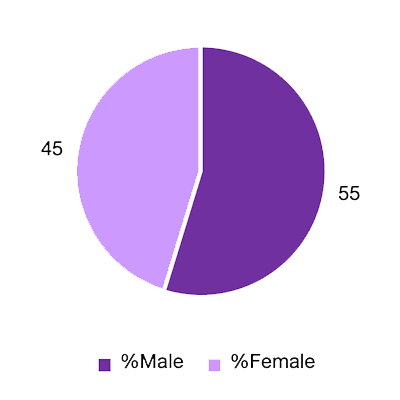
Top management positions
(% of Total Top Management Workforce)
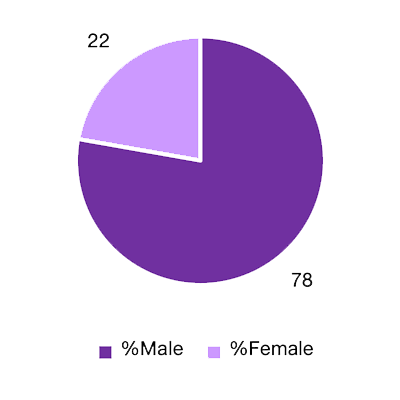
Junior management positions
(% of Total Junior Management Workforce)
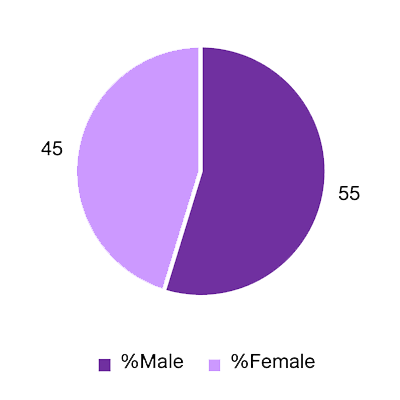
Management positions in revenue-generating functions
(% of all such managers)
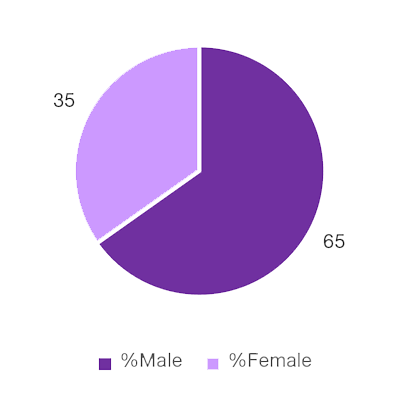
STEM (Science, Technology, Engineering, Mathematics) - related positions
(% of total STEM positions)
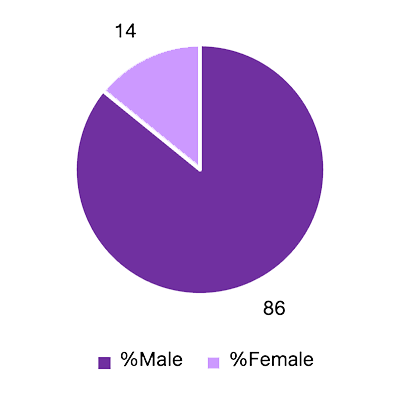
Nationality diversity
| Nationality | Share in total workforce (as % of total workforce) |
Share in all management positions (as % of total management workforce) |
|---|---|---|
| Thai | 70.4 | 1.0 |
| Burmese | 25.6 | 0.0 |
| Cambodian | 3.8 | 0.0 |
Employees’ care
The Company places importance on building a good human resource management system, from recruitment of new employees, standard compensation management, setting goals and plans for development of employee potential to promote career advancement and growth, paying attention to the safety and health of employees and giving freedom and respect to employees’ rights to represent, collectively assemble or negotiating with 100% of all employees. There is a welfare committee in the workplace consisting of employer and elected employee representatives to take part in discussions with employers, both in terms of other welfare besides what is prescribed in basic laws, and activities within the Company.
Flexible Working Operations
The Company has a policy that supports flexible working hours and allows employees to work according to suitable schedules, aligning with their job requirements and individual needs. There are various work schedules available, including part-time and full-time positions.
Family Support
- Female employees who recently have children receive a gift of 1,000 baht/time
- Female employees have the rights to leave for childbirth, not more than 98 days or 14 weeks and to receive wages during the leave but not to exceed 45 days, which is in accordance with the Thai’s Labor Laws. If a pregnant employee holds a first-class medical certificate that shows the employee cannot work on the usual duty, the employee has the right to ask an employer to change a job on a temporary basis before or after birth.
- Employees can apply for additional personal leave or annual leave to care for family members (i.e., children, spouse, parents). The company will consider the suitability on a case-by-case basis.
Furthermore, the company has initiated the “Happy Workplace” project to enhance employee well-being, which includes:
Happy consultation
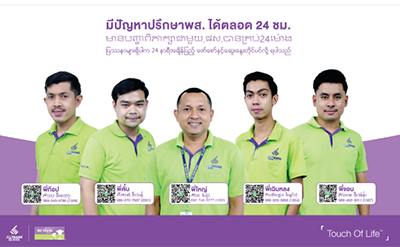
This program focuses on managing workplace stress and offers confidential consultations to employees dealing with various challenges, including emotional distress, stress, work-related issues, and family matters. Employees have access to a 24/7 hotline or can schedule private appointments to receive counseling and problem-solving assistance, helping them feel relieved and less anxious.
Happy Body
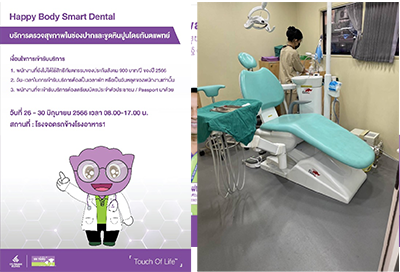
Smart Dental provides oral health check-ups and dental scaling services by dentists.

Songkran Sports Day aims to promote physical activity and strengthen the relationships among employees.
Employee Development Project
Successor Project

Current overview of business operations sees continued growth and continuous development and, in the era of competition that is constantly changing in the business world, the Company realizes and still sees the importance of human resources as the key mechanism that drives the organization to achieve its goals and achieve sustainable success. In order to prepare for and support the aforementioned changes, the Company has selected and positioned the personnel of the organization to enter the process of placement into important positions at the executive level, collectively called Successors, who are considered and selected by the Board of Directors.
Description of program objective/business benefits
- To develop various skills of successors and equip them in all aspects for higher-level positions succession.
- To ensure that the Company does not lack human resources for higher-level position replacements.
Quantitative Impact of Business Benefits
Employees participating in the project, such as the Water Consumption Reduction Group, can reduce production costs for the Company by 522,574.15 baht, and the Pressure Transmitter (PT) and Temperature Transmitter (TT) calibration frequency extension group can reduce production costs for the Company by 232,688 baht.
FTE participating in the program
20 people, or approximately 0.24% of total employees of the Company
Training program “Theory - 9 Modules”
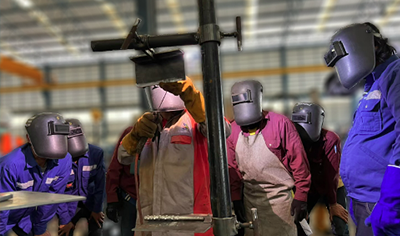
The Company, being an industrial factory with a vast number of machineries used in production processes, highly values the presence of skilled personnel responsible for the maintenance and care of these machines. Therefore, the 'Theory - 9 Modules' training course has been designed to transfer the knowledge and craftsmanship know-how essential to the Company. This enables employees to perform their tasks efficiently.
Description of program objective/business benefits
To enhance the practical skills of employees in the position of skilled workers.
Quantitative Impact of Business Benefits
The Company has skilled workers who have successfully passed the theoretical assessment, totaling 12 persons.
FTE participating in the program
77 people, or approximately 0.95% of total employees of the Company
